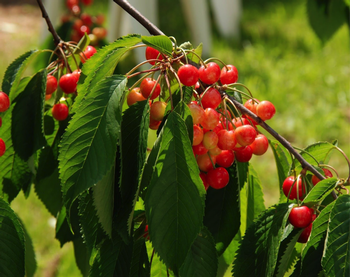Cherry
-
Scientific NamePrunus avium (sweet) Prunus cerasus (sour)
-
General InformationCherries are deciduous trees available in sweet (for fresh eating) or sour (for preserving or jams) varieties. Most require between 600 to 900 chill hours (below 45 degrees Fahrenheit). High temperatures contribute to fruit deformities and foggy areas contribute to fruit disease, making this fruit challenging to grow in Marin.
 Photo: Pixabay
Photo: Pixabay -
When to Plant
Bare root: Cherry trees are most commonly available as bare root trees grafted on rootstock. They are available mid-December to mid-January and can be planted immediately or kept in moist sand or sawdust outside until planted in the ground in early spring.
Grafting: Cut a newly sprouted bud stick from a healthy cherry tree in late spring or summer. Cut leaves off bud stem. Make cut at midpoint of each leaf stem. Cut groove in bark of stock tree halfway around the stock branch at least 15 inches from trunk. Cut a second groove starting at the first groove and running down about two inches. Open up the bark so it's ready to receive the bud stick. Cut off the stick about a half inch below the bud. Remove the bark gently so the bare wood is exposed. Cut the stock branch off when the bud shows signs of growth.
-
Planting
Cherries like long, warm summer days and cool nights. Choose the sunniest spot in your garden that has good air flow and upward space for the tree to grow. Leave about 30 to 40 feet between individual trees, unless planting dwarf varieties that typically reach about 6 feet in size. Allow 14 to 20 feet between trees.
Learn more about planting bare root trees.
-
Soil Requirements
Cherry trees grow best in deep (at least four feet), well-drained loam with low alkalinity and low salinity. Do not plant cherries in excessively sandy, heavy, or wet soils. Although rootstocks have gotten better at surviving these conditions, it’s not recommended unless planted on a berm or hill.
-
Water Requirements
After planting in winter/spring and watering initially, use rainfall as a guide to keep the soil moist. Cherries require irrigation during the growing season and summer months. For smaller trees, water deeply and slowly, away from the trunk, every one to two weeks. If winter rains do not wet the entire root zone, be sure to remedy this with your own irrigation practices. For larger trees, irrigate deeply and less frequently, ensuring the entire root zone is re-wetted with each irrigation.
-
Fertilizing
When first planting a bare root tree, just add a little top dressing compost. In the first year only light fertilization is needed and not unless there is six to eight inches of growth. Three pounds of aged/composted poultry or rabbit manure may be used. Fertilize established trees after harvest. Look for an organic fruit tree blend in the range of 16-16-16 at your local nursery. Follow instructions on the box.
-
Pollination
Pollinated by honeybees. Plant two varieties of sweet cherries within 100 feet of each other for best production. Learn space saving ideas like grafting a pollinizer limb onto a tree or planting two pollinizing varieties in one hole.
-
Harvesting
Cherries usually ripen May through July depending on climate, location, and variety. Dark skin varieties can be picked when fruit reaches a solid dark color and has a little give. The longer the fruit is on the tree, the better the flavor. They do not continue to ripen after harvest. Pick with the stem attached to prevent injury to the fruit and take care not to break or remove the spur (fruiting twig) from the tree. Bird damage to sweet cherries as they begin to ripen is often severe and can be difficult to prevent.
-
Storage
Keep harvested fruit as close to 32 degrees F as possible without freezing. Refrigeration under fairly high relative humidity helps with moisture loss and fruit shrivel.
-
Good Varieties for Marin
'Bing': most common sweet variety for taste, large size, and firm fruit
Pollinators: 'Black Tartarian' 'Early Burlat' 'Jubilee' 'Rainier' 'Stella'
'Stella': sweet, dwarf, self-fruitful
'Brooks': sweet red variety that matures earlier than Bing and tolerates hot climates
Pollinators: 'Rainier' 'Early Burlat' 'Tulare'
'Rainier': popular sweet blush-colored variety
Pollinators: 'Bing' 'Stella' 'Royal Ann' 'Montmorency'
'Montmorency': most common sour variety, high yielding, self-fruitful
-
Helpful Tips
Cherries do not like heavier soils and have a tendency to become waterlogged. Be sure to plant in well-draining areas. Keep the tree area free from weeds while becoming established. Young trees do not like competition from lawns.
Learn more on pruning cherry trees.
-
Common Problems
Poor harvest. Birds can pick a tree clean in one to two days. Try noise or scare devices, net coverings, or framing the tree in netting if feasible.
Root and crown rot caused by water-mold fungi. Be sure the soil is not too heavy or compact, and keep the tree base dry.
-
Pests- Diseases & More
Pocket gophers can injure or kill a tree by feeding on the roots. Consider trapping.
Bacterial canker – a disease that can kill young trees, but is not serious in mature trees. Masses of amber-colored gum are produced on affected branches and wood becomes malformed.
Buckskin – a virus-like disease that stunts growth severely. Avoid planting cherries near privet hedges that could harbor leaf hoppers that spread the disease.
High temperatures can sunburn limbs and are believed to cause double or “spur” fruit, which are considered undesirable to commercial growers, but may be tolerable for the home gardener.

